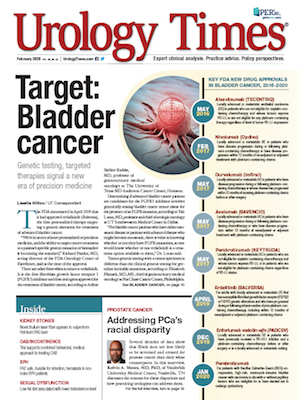Publication
Article
Urology Times Journal
Study compares prostate cancer treatment functional outcomes
Author(s):
"Irrespective of treatment, fewer than half of men reported the ability to maintain erections sufficient for intercourse at 5 years," writes Badar M. Mian, MD.


“Journal Article of the Month” is a new Urology Times section in which Badar M. Mian, MD (left), offers perspective on noteworthy research in the peer-reviewed literature. Dr. Mian is professor of surgery in the division of urology at Albany Medical College, Albany, NY.
Functional outcomes following treatment for clinically localized prostate cancer depend not only on the type of treatment but also the severity of disease and baseline functional characteristics. The prospective, population-based, Comparative Effectiveness Analysis of Surgery and Radiation (CEASAR) study was designed to inform men of the comparative harms of contemporary prostate cancer treatment options. A recent report from this observational study analyzed functional outcomes up to 5 years after treatment of localized prostate cancer stratified by disease risk category (JAMA 2020; 323:149-63).
Men with clinically localized prostate cancer from five population-based Surveillance, Epidemiology, and End Results Program registries and the observational Cancer of the Prostate Strategic Urologic Research Endeavor registry were recruited from 2011 to 2012. Patients completed the 26-item EPIC and 36-Item Short Form surveys (score range, 0-100) at baseline, 6 months, and 1, 3, and 5 years after treatment. Favorable-risk disease was defined as clinical stage cT1 to cT2bN0M0, PSA <20 ng/mL, and Grade Group 1-2) and unfavorable-risk disease defined as clinical stage cT2cN0M0, PSA of 20-50 ng/mL, or Grade Group 3-5. There was no statistically significant difference in prostate cancer-specific survival between favorable- and unfavorable-risk groups at 5 years.
Also by Dr. Mian:Could mpMRI replace prostate Bx for surveillance protocols?
Of the 1,386 men with favorable-risk disease, 675 (49%) underwent nerve-sparing prostatectomy, 363 (26%) underwent active surveillance, 261 (19%) underwent external beam radiation therapy (no androgen deprivation therapy), and 87 (6%) underwent brachytherapy. Clinically meaningful declines in sexual function scores from baseline to 5 years were seen in each group, including –32 for nerve-sparing prostatectomy, –32 for EBRT, –22 for brachytherapy, and –20 for active surveillance. Compared to active surveillance, there was worse sexual function score in the nerve-sparing prostatectomy group (mean difference, –15.2) at 3 years and the brachytherapy group at 1 year (mean difference, –10.1). At 5 years, men who underwent prostatectomy reported a modestly higher rate of erections insufficient for intercourse compared with men on active surveillance (57% vs. 61%, p<.001).
At 5 years, prostatectomy was associated with worse urinary incontinence score compared with all other options by a median difference of 10-12 points (p<.001). However, prostatectomy was associated with better urinary irritative function than active surveillance and brachytherapy with a median difference of 5-6 points (p<.001). At 5 years, nerve-sparing prostatectomy was associated with a slightly higher rate of incontinence than active surveillance (10% vs. 7%, p=.04). Brachytherapy was associated with worse bowel function score at 1 year compared with active surveillance and nerve-sparing prostatectomy (adjusted mean difference, −5.0, p<.001).
In the unfavorable-risk group of 619 men, 402 (65%) underwent prostatectomy and 217 (35%) underwent EBRT+ADT. In men who had erections sufficient for intercourse at baseline, 63 of 204 (31%) treated with prostatectomy and 37 of 80 (46%) treated with EBRT and ADT reported sufficient erections at 5 years. At 5 years, EBRT+ADT was associated with a lower likelihood of insufficient erections (75% vs. 80%, p=.01); however, there was no difference in sexual bother score between the groups.
EBRT+ADT was associated with better incontinence function than prostatectomy (5 year adjusted mean difference, 23.2, p<.001). At 5 years, EBRT+ADT had a lower rate of moderate or big problems (bother) with urinary function (13% vs. 17%, p=.005). Men treated with EBRT+ADT reported a clinically meaningful decline in bowel function. When compared to prostatectomy, EBRT+ADT was associated with worse bowel function scores at 1 year (adjusted mean difference, −4.1, p<.001).
EBRT+ADT was associated with clinically meaningful decline in hormonal function from a median domain score of 90 at baseline to a low of 81 at 6 months. Men treated with EBRT+ADT had a statistically significantly worse hormone function than prostatectomy, which was clinically meaningful only at 6 months (adjusted mean difference, −5.3, p<.001).
Next: Decline in sexual function noted with all treatment optionsDecline in sexual function noted with all treatment options
Irrespective of treatment, fewer than half of men reported the ability to maintain erections sufficient for intercourse at 5 years. Prostatectomy was associated with worse 5-year sexual function scores than EBRT+ADT in the unfavorable-risk group; however, sexual bother scores were similar. Prostatectomy was associated with worse urinary incontinence while brachytherapy had worse urinary irritative function and bowel function. Similarly, men who received EBRT+ADT reported clinically meaningful worsening of bowel and hormonal functions.
Read: What do recent studies tell us about finasteride and PCa?
The data are not clear about unilateral or non-nerve-sparing surgery or the duration of ADT. For unfavorable-risk cancer, it is common practice to use ADT with EBRT for 18 to 36 months. Yet, the clinically meaningful decline in hormonal function in this study was only noted at 6 months. This may be due to shorter duration of ADT, resulting in lesser decline in the hormonal and sexual functions noted with EBRT+ADT.
Men in all treatment groups experienced clinically meaningful declines in sexual function and urinary function, including those on active surveillance, but the differences in functional scores diminished over time. This information on comparative functional decline, especially when stratified for risk category, is quite useful when counseling patients about the comparative adverse outcomes from our most common treatment options
































